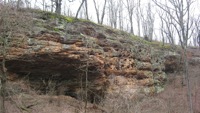Difference between revisions of "Rock shelter"
(Created page with 'File:lighterstill.jpgright|frame A '''rock shelter''' (also known as a ''rockhouse'', ''crepuscular cave'', or ''abri'') is a sha...') |
m (Text replacement - "http://" to "https://") |
||
| (2 intermediate revisions by one other user not shown) | |||
| Line 3: | Line 3: | ||
A '''rock shelter''' (also known as a ''rockhouse'', ''crepuscular cave'', or ''abri'') is a shallow cave-like opening at the base of a bluff or cliff. | A '''rock shelter''' (also known as a ''rockhouse'', ''crepuscular cave'', or ''abri'') is a shallow cave-like opening at the base of a bluff or cliff. | ||
| − | ''Rock shelters'' form because a rock stratum such as sandstone that is resistant to [[erosion]] and weathering has formed a cliff or bluff, but a softer stratum, more subject to erosion and [ | + | ''Rock shelters'' form because a rock stratum such as sandstone that is resistant to [[erosion]] and weathering has formed a cliff or bluff, but a softer stratum, more subject to erosion and [https://en.wikipedia.org/wiki/Weathering weathering], lies just below the resistant stratum, and thus undercuts the cliff. |
Many rock shelters are found under waterfalls. | Many rock shelters are found under waterfalls. | ||
| − | ''Rock shelters'' are often important archaeologically. Because rock shelters form natural [[shelters]] from the [[weather]], prehistoric humans often used them as living-places, and left behind debris, [[tools]], and other [[artifacts]]. In mountainous areas the shelters can also be important for [ | + | ''Rock shelters'' are often important archaeologically. Because rock shelters form natural [[shelters]] from the [[weather]], prehistoric humans often used them as living-places, and left behind debris, [[tools]], and other [[artifacts]]. In mountainous areas the shelters can also be important for [https://en.wikipedia.org/wiki/Mountaineering mountaineers]. In western Connecticut and eastern New York, many rock shelters are known by the colloquialism "leatherman caves", as they were inhabited by the [https://en.wikipedia.org/wiki/Leatherman_(vagabond) Leatherman] over three decades in the late 19th century. |
| − | In arid areas, wind erosion (eolian erosion) can be an important factor in ''rockhouse'' formation. In most humid areas, the most important factor in rockhouse formation is [ | + | In arid areas, wind erosion (eolian erosion) can be an important factor in ''rockhouse'' formation. In most humid areas, the most important factor in rockhouse formation is [https://en.wikipedia.org/wiki/Frost_weathering frost spalling], where the softer, more porous rock underneath is pushed off, tiny pieces at a time, by frost expansion from water frozen in the pores. Erosion from moving water is seldom a significant factor. |
| − | The [ | + | The [https://en.wikipedia.org/wiki/Minuartia_cumberlandensis Cumberland stitchwort] (Minuartia cumberlandensis) is an endangered species of plant which is found only in rock shelters in Kentucky and Tennessee. |
| + | ==See also== | ||
| + | *'''''[[Cave]]''''' | ||
| + | *'''''[[Crag]]''''' | ||
[[Category: Earth Science]] | [[Category: Earth Science]] | ||
Latest revision as of 01:58, 13 December 2020
A rock shelter (also known as a rockhouse, crepuscular cave, or abri) is a shallow cave-like opening at the base of a bluff or cliff.
Rock shelters form because a rock stratum such as sandstone that is resistant to erosion and weathering has formed a cliff or bluff, but a softer stratum, more subject to erosion and weathering, lies just below the resistant stratum, and thus undercuts the cliff.
Many rock shelters are found under waterfalls.
Rock shelters are often important archaeologically. Because rock shelters form natural shelters from the weather, prehistoric humans often used them as living-places, and left behind debris, tools, and other artifacts. In mountainous areas the shelters can also be important for mountaineers. In western Connecticut and eastern New York, many rock shelters are known by the colloquialism "leatherman caves", as they were inhabited by the Leatherman over three decades in the late 19th century.
In arid areas, wind erosion (eolian erosion) can be an important factor in rockhouse formation. In most humid areas, the most important factor in rockhouse formation is frost spalling, where the softer, more porous rock underneath is pushed off, tiny pieces at a time, by frost expansion from water frozen in the pores. Erosion from moving water is seldom a significant factor.
The Cumberland stitchwort (Minuartia cumberlandensis) is an endangered species of plant which is found only in rock shelters in Kentucky and Tennessee.
